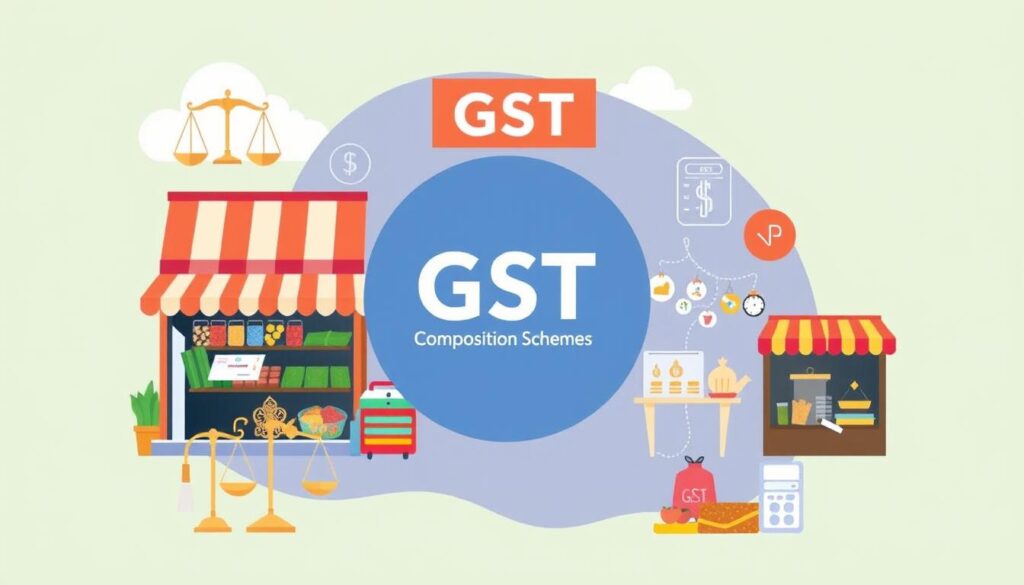Are you a GST-registered business owner finding GST return filing hard? Don’t worry! This guide will help you in How to do GST return filing process. You’ll learn how to stay compliant and avoid penalties or delays.

How to do GST Return Filing
GST (Goods and Services Tax) return filing is a must for all GST-registered businesses. It’s about reporting your sales, revenue, and tax collected to the tax authorities. If you miss the deadline, you might face delays, penalties, and interest charges. So, it’s key to know How to do GST return filing and how to file it online.
Key Takeaways
- GST return filing is a mandatory process for all GST-registered businesses
- Timely and accurate filing is crucial to avoid penalties and interest charges
- The process involves entering business information, calculating net tax, and submitting the return through the GST portal
- Understanding the different GST return forms and their deadlines is essential
- Familiarizing yourself with the GST portal navigation and payment methods can streamline the filing process
Understanding How to do GST Return Filing Basics
Getting started with GST (Goods and Services Tax) returns might seem tough. But, knowing the basics can make it easier. GST return filing means sending tax info to the government. This ensures you pay taxes on time. There are many GST return forms, so it’s key to know which one you need.
What is GST Return Filing?
GST return filing is about reporting your business’s GST transactions. This includes sales, purchases, and tax credits. You use different GST return forms for this. These forms help you meet your tax duties and keep good relations with tax authorities.
Types of GST Returns
There are 19 GST return forms for filing online. Forms like GSTR-1, GSTR-2A, and GSTR-3B have different uses. Each form is for a specific group, like regular dealers or e-commerce operators.
Importance of Timely Filing
On-time GST return filing is vital for businesses. Missing deadlines can lead to penalties and interest. This can hurt your finances. Staying on top of deadlines helps avoid extra costs and keeps you in good standing with the tax authorities.

“Proper GST return filing is essential for businesses to comply with tax regulations and maintain a healthy financial standing.”
Understanding GST return basics is crucial. It helps you know which forms to use and why timely filing is important. This way, you can avoid penalties and keep your finances healthy.
GST Registration Requirements and Eligibility
The GST registration process is key for businesses in India. Your business must meet certain criteria to register for GST. These include annual turnover, business type, and location. Knowing these requirements helps you through the registration process.
Businesses with an annual turnover over ₹40 lakh (₹20 lakh in some states) must register for GST. But, some businesses, like service providers, might only need ₹10 lakh. It’s vital to check the GST eligibility criteria to see if your business qualifies.
The GST registration process usually takes 2-6 working days. Once you’re registered, you get a unique GST Identification Number (GSTIN). This is crucial for filing GST returns and handling your tax duties.
Not registering for GST can lead to penalties of up to 10% of the tax owed, with a minimum of ₹10,000 for honest mistakes. Intentional tax evasion can result in a 100% penalty of the tax owed.
Remember, GST registration is vital for tax compliance and avoiding penalties. By knowing the eligibility and requirements, you can ensure your business thrives in the GST system.
“Registering for GST is a crucial step for businesses in India. Understanding the eligibility criteria and requirements can help you navigate the process smoothly and avoid potential penalties.”
Essential Documents Needed for GST Filing
When it comes to GST filing documents, having the right paperwork is key. As a GST-registered business, keeping detailed records of your transactions is vital. This includes invoices and financial statements for a smooth GST return filing.
Business Transaction Records
It’s important to keep accurate records of your business dealings. This includes sales, purchases, and taxes collected. This info is crucial for preparing your GST invoice requirements and figuring out your GST liability.
Invoice Documentation
Invoices are a big part of GST filing. Make sure your invoices have all the GST details needed. This includes the customer’s GSTIN, GST rates, and taxable values. Good invoice documentation helps you claim input tax credits and avoid GST audit issues.
Previous Returns and Financial Statements
Your past GST returns and financial statements are very useful for current filings. They help you check your transactions, spot any issues, and follow GST rules.
Having a good system for storing and finding these important documents is essential. It makes GST filing easier and helps during audits and other regulatory checks.
How to do GST Return Filing
Filing GST returns is key for businesses in India. It involves several steps to report accurately and on time. Here’s a guide to help you through the GST return filing process.
- Login to the GST Portal: Start by logging into your GST portal account with your registered details.
- Access the Returns Dashboard: Go to the Returns dashboard to find the GST return forms.
- Select the Appropriate Form: Pick the right GST return form based on your business and the period.
- Verify Pre-Populated Data: Check the data already filled in the form from your previous filings and invoices.
- Add Additional Information: Enter any extra details or changes needed for the current period.
- Calculate Tax Liability: Make sure the tax liability is correct based on your transactions and tax rates.
- Review and Submit: Double-check the information and then submit the GST return form.
- Make the Payment: If you owe tax, pay it through the GST portal’s payment options.
The GST return filing process can differ for various taxpayers. But the basic steps above give a general guide for the GST return filing process.
| GST Return Form | Taxpayer Category | Due Date |
|---|---|---|
| GSTR-1 | Regular Dealers | 11th of the next month |
| GSTR-4 | Composite Taxpayers | 18th of the next month |
| GSTR-8 | E-commerce Operators | 10th of the next month |
| GSTR-7 | Tax Deductors | 10th of the next month |
| GSTR-9C | Businesses with Turnover >INR 2 Crores | 31st December of the next fiscal year |
By following this guide and knowing your business category’s needs, you can have a smooth GST return filing process. This ensures you stay in line with GST regulations.
Online GST Portal Navigation Guide
Understanding how to use the GST portal is key to filing GST returns. First, you need to create a secure account. This means setting up your login details and adding extra security steps.
Creating GST Portal Account
The GST portal makes logging in easy to keep your business info safe. Here’s how to make your account:
- Go to the official GST portal and click “Register”.
- Enter your business name, PAN, and contact info.
- Choose a strong password and add two-factor authentication, like SMS or email.
- Finish by verifying your mobile and email.
Dashboard Overview
After setting up, you’ll see the GST portal’s dashboard. It’s your main spot for GST tasks. Here, you can:
- Check your business info and registration.
- File GST returns and manage payments.
- See your transaction history and download documents.
- Get the latest GST news and updates.
Security Measures and Authentication
The GST portal keeps your business data safe. It uses two-factor authentication and more:
- Digital Signature Certificate (DSC) for secure signing.
- Electronic Verification Code (EVC) for when you don’t have a DSC.
- Secure encryption and access controls for your data.
- Regular security updates and checks.
Knowing how to navigate the GST portal and its security features makes filing GST returns easier. It ensures a smooth and safe experience.
Common GST Return Forms and Their Purposes
Filing GST returns is key for tax compliance in India. Businesses need to know about different GST return forms. Each form has its own purpose, making it important to understand them well.
The most common GST return forms include:
- GSTR-1 – This form is used to report outward supplies, such as sales and deliveries, made during the tax period.
- GSTR-3B – This is a monthly summary return that captures the total tax liability and input tax credit (ITC) claims for the tax period.
- GSTR-2A – This form is an auto-generated statement of inward supplies, providing businesses with a comprehensive view of their purchases.
Each form has its own role. For example, GSTR-1 deals with outward supplies, while GSTR-3B covers the total tax and ITC claims. Knowing how to use these forms is key for filing GST returns correctly and on time.
| GST Return Form | Purpose | Filing Frequency |
|---|---|---|
| GSTR-1 | Reporting outward supplies (sales and deliveries) | Monthly or Quarterly (based on turnover) |
| GSTR-3B | Summary of total tax liability and input tax credit claims | Monthly |
| GSTR-2A | Auto-generated statement of inward supplies (purchases) | N/A (Auto-generated) |
By learning about the different GST return forms and their uses, businesses can meet their tax duties well. This helps in making the Goods and Services Tax (GST) system work smoothly in India.
GST Payment Methods and Processing
As a business owner, knowing how to handle GST payments is key. There are many ways to pay, from online to offline. We’ll look at the GST payment methods and how they work.
Available Payment Options
The GST payment system offers many choices. You can pay online or offline, depending on what you need. Here are some options:
- Online payment methods: Net banking, credit/debit cards, Immediate Payment Services (IMPS), and Unified Payment Interface (UPI)
- Offline payment options: Over-the-counter (OTC) payments via cheque, demand draft, or cash, as well as National Electronic Fund Transfer (NEFT) and Real-Time Gross Settlement (RTGS)
Choosing how to pay depends on your preference and the GST portal’s rules.
Payment Verification Process
After picking your GST payment method, you need to make sure your payment goes through. You’ll get a challan, which is like a receipt. It helps track your payment.
The GST portal updates your payment status in real-time. This makes it easy to see if everything is okay.
Handling Payment Failures
If your payment doesn’t go through, you need to fix it fast. Payment failures can happen for many reasons. Here’s what to do:
- Find out why it failed and fix it.
- Try paying again, making sure all details are right.
- Keep an eye on the payment status and ask for help if needed.
Quickly solving payment failures helps you stay on track with your taxes. This way, you avoid extra fees or penalties.
Due Dates and Late Filing Penalties
Filing GST returns on time is key to avoiding penalties. The due dates for GST returns depend on the type of return and the business type. Regular dealers usually file monthly or quarterly GST returns. If you miss these deadlines, you’ll face penalties and interest.
To stay on track with your GST return duties, know the important due dates:
- GSTR-1 (outward supplies): The filing deadline for GSTR-1 varies with your business’s sales. Businesses with over ₹5 crore in sales must file monthly. Those with sales up to ₹5 crore can file quarterly under the QRMP scheme.
- GSTR-3B (summary return): Regular dealers must file GSTR-3B by the 20th of the next month.
Missing GST return deadlines can lead to big penalties. The fines range from ₹25 to ₹10,000, based on your business’s annual sales. For those filing no GSTR-1, the daily late fee is ₹10 to ₹20 under the CGST Act and SGCT Act/UTGST Act.
Extensions for GST return filing are sometimes available. But they’re not for reasons like staff on maternity leave or key personnel abroad. It’s vital to keep up with GST return due dates and file on time to dodge penalties and interest.
“Timely filing of GST returns is essential for maintaining compliance and avoiding penalties.”
Avoiding Common GST Filing Mistakes
Keeping up with GST rules is vital for businesses. But, GST filing errors can cause big problems. Knowing how to avoid these mistakes is crucial for accurate and on-time GST return filing.
One big issue is manual errors, which can lead to wrong data and fraud. It’s also important to get tax slab calculations right to avoid paying too much tax. Businesses must file a NIL return, even if they had no transactions, to stay compliant.
It’s easy to get confused between zero-rated and nil-rated supplies. This can lead to mistakes in GST return filing. Businesses must also correctly file reverse charge mechanism (RCM) transactions to follow the rules.
- Checking Input Tax Credit (ITC) provisions related to reverse charge mechanism and blocked credit to prevent double payment of tax
- Disclosing transactions under the correct GST heads to prevent legal issues and ensure accurate tax payments
- Claiming only eligible Input Tax Credit (ITC) by thoroughly verifying auto-populated forms like GSTR-2A and GSTR-3B
By tackling these common GST filing errors and following best practices, businesses can avoid penalties. Using GST-compliant software can also help reduce errors.
| Common GST Filing Mistakes | Consequences |
|---|---|
| Incorrect GSTIN entry | Rejection of the return |
| Discrepancies between sales and purchase data | Identified by tax authorities |
| Failure to account for Reverse Charge Mechanism (RCM) | Legal issues and non-compliance |
| Incorrect Input Tax Credit (ITC) claims | Double payment of tax |
| Late filing of GST returns | Penalties |
By being careful and having strong controls, businesses can avoid GST filing errors. This helps them stay compliant and improves their financial and operational health.
Conclusion
Filing GST returns is key for businesses in countries with the Goods and Services Tax (GST) system. It ensures taxes are calculated right and keeps you in good standing with tax authorities. It also helps the economy grow.
As a business owner, knowing how to file GST returns is crucial. It helps you avoid penalties and audits. It also improves your cash flow and lets you use input tax credits.
Keeping up with GST return filing is essential for your business’s success. Stay informed, meet deadlines, and use available resources. This way, you can confidently navigate the GST system and help the country’s economy grow.
FAQ
Q: What is GST return filing?
A: GST return filing means sending tax info to the government. You report your sales, income, and taxes collected.
Q: What are the different types of GST returns?
A: There are 19 GST return forms, like GSTR-1 and GSTR-3B. Each form has its own purpose and filing schedule.
Q: Why is timely GST return filing important?
A: Filing on time is key to avoid penalties. Late filing can lead to fines and extra charges.
Q: What are the GST registration requirements and eligibility criteria?
A: You need GST registration if your sales hit certain thresholds. It depends on your business type, location, and sales volume.
Q: What essential documents are needed for GST filing?
A: You’ll need records of business deals, invoices, past GST returns, and financial statements. Accurate records of sales, purchases, and taxes are vital.
Q: How to do GST return filing?
A: First, log into the GST portal. Then, go to the returns section, pick your form, fill in the details, and submit it.
Q: How do I navigate the GST portal?
A: Log in securely with your credentials. Create an account, set up security, and get familiar with the dashboard.
Q: What are the common GST return forms and their purposes?
A: Forms like GSTR-1 and GSTR-3B are for different things. GSTR-1 is for what you sell, GSTR-2A for what you buy, and GSTR-3B for monthly reports.
Q: What are the GST payment methods and the payment process?
A: You can pay GST through net banking, credit cards, or NEFT/RTGS. Choose your method, enter the amount, and finish the payment.
Q: What are the GST return due dates and the consequences of late filing?
A: Due dates vary by return type and business type. Filing late can result in penalties and extra charges.
Q: What are the common GST filing mistakes and how to avoid them?
A: Mistakes include wrong data, misclassifying goods, and bad invoice details. Double-check your entries, match data with financial records, and keep up with GST rules.










